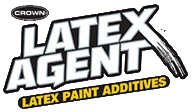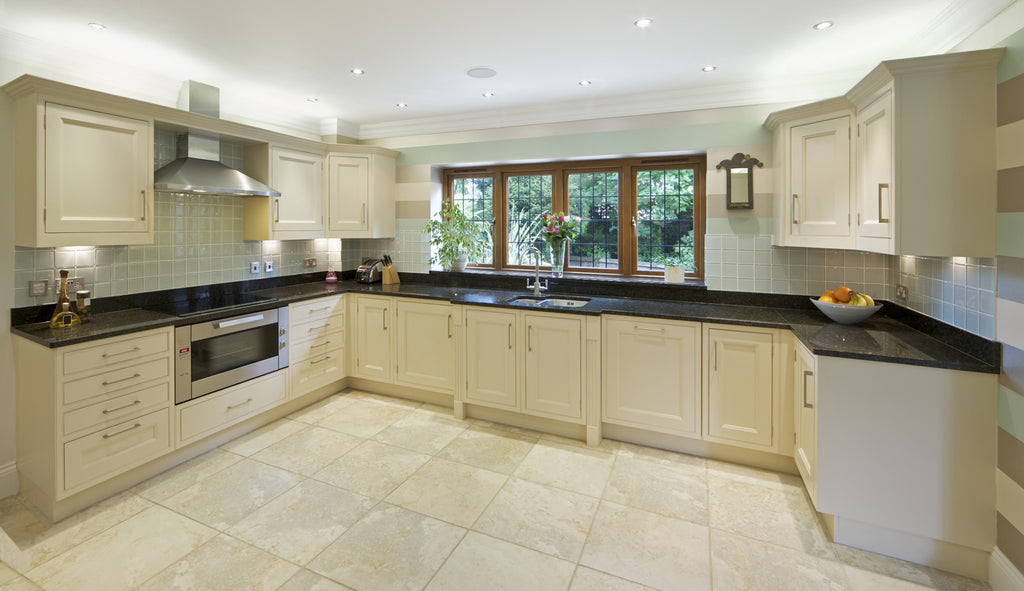... paint your kitchen cabinets without sanding
Posted by : Latex Agent /
How to ... paint your kitchen cabinets without sanding

One of the most rewarding home improvement projects is putting a fresh coat of paint on your kitchen cabinets. A new color brightens up your kitchen, and can give it a complete updated look. But at the same time, it can be a time consuming and scary project. Since most kitchens have a top coat with a high gloss (like oil paint, polyurethane, or a high gloss latex paint), a fresh layer of paint usually doesn’t stick to the current top coat.
Browsing on the internet, you will find lots of how-to guides for this project. Most of them come down to the following steps:
- Remove doors and hardware
- Clean the surface
- Sand
- Clean the surface again
- Prime
- Paint
- Reinstall doors and hardware
According to these guides, a lot of prep work is involved to make sure that your new coat of paint sticks well to your cabinets. You will have to touch each area four times before you can actually start painting. Four times! If you want to have your kitchen ready before your next dinner party, you better run to the paint store now. Or take a few minutes to finish reading this article, and have time to spare.
A new solution

We want to introduce Oil Bond to you. Oil Bond is a paint additive that makes repainting projects, like your kitchen cabinets, much easier, without compromising on the result. Oil Bond is engineered to help latex paint stick to glossy surfaces. This means that with Oil Bond, you can substitute all those prep steps with one simple wipe. Your project guide is now:
- Remove doors and hardware
- Wipe
- Mix
- Paint
- Reinstall doors and hardware
Let us walk you through this project step by step. But before we start …
… know your surface
Kitchens come in all shapes and sizes. And cabinets in all sorts of material with different kind of finishes. Plastic laminate finishes are difficult to repaint, and require special paints and techniques. If your cabinets have a plastic laminate surface, you won’t be able to use Oil Bond. We advise you to check with a knowledgeable paint dealer, and test a sample of the paint you wish to use in an inconspicuous area to ensure that it will bond to the material.
Remove doors and hardware

Start your project by emptying out your kitchen cabinets and drawers, and remove all cabinet doors, drawers, knobs, handles, and other loose parts. Place these in bags and mark where each item comes from, so you can install it back to its proper place at the end of the project.
If you are planning on changing the knobs and handles at the end of the project, this is the time to fill the old hardware holes. Using a putty knife, fill the holes with wood putty. You can also fill any dings in the cabinets. To make sure that you end up with a smooth surface, lightly sand the putty with 100-grit sandpaper once the putty is dry.
Wipe
Now it’s time to pull out the Latex Agent Oil Bond and save a lot of time. After a good shake, you pour a bit of Oil Bond on a clean, lint free rag. With this rag, you wipe down the entire surface that you are planning to repaint. Make sure that you reach every little piece of surface. This simple wipe does 3 things in one:
- It cleans the surface.
- It deglosses the surface (the same thing that sanding does)
- It deposits self-crosslinking resins on the surface that will help the paint to stick to the prepared surface.

Before you can paint, your surface needs to be dirt and grease free. Oil Bond does this cleaning. However, if your surface is really greasy, you probably need a heavy duty cleaner like TSP to get your surface clean.
The next thing that Oil Bond does, is it deglosses the surface. This is where you will save a lot of time, and a lot of mess. The traditional method of deglossing a surface, is by sanding. But sanding takes a lot of time, and creates a big mess that needs to be cleaned up. By wiping a layer of Oil Bond on your surface, you do exactly the same in much less time and without the mess.
Finally, Oil Bond deposits a layer of self-crosslinking resins on the surface. You will see this when the Oil Bond dries up as a white milky looking layer. These resins are the real magic behind Oil Bond. They grab hold on the old paint on your cabinet at one side, and to the resins in your paint on the other side, creating a non-peel finish.
Let the Oil Bond dry for one to two hours before you start painting.
Mix
Next, you mix some Oil Bond into your choice of latex paint. The ratio is 1 part of Oil Bond to 8 parts of paint. That is 16oz. of Oil Bond for 1 gallon of paint. Oil Bond has been tested with a wide variety of water-based paints. You don’t need a specific brand or type. You can pick your favorite latex paint in the color of your choice!

Paint
Now it is time to start painting your kitchen cabinets. Make sure that all items that you are planning to paint are setup for easy access, edges are taped off with painters tape, and the floor is covered with tarps (or old newspapers) to prevent paint on places where you don’t want it.
Start by painting the inside edges and openings of the face frames, then the sides of the cabinet, and finally the frame fronts. This allows you to work quickly in the less critical areas, and enables you to see and correct any drips or smudges on the most visible areas.
After this, paint your doors, and fronts of your drawers. Lay your doors on a flat surface at a spot where you don’t have to move them until they are dry. If you place them on small blocks, you can also easily paint the sides without the risk of the doors sticking to the surface you lay them on.
Always apply a thin coat of paint. This leaves you with less visible brush strokes, and the paint dries more quickly. It is better to do two thin layers of coat, than one thick one. Make sure you let the paint dry between paint coats. The Oil Bond in your paint does not affect dry time of your paint, so just follow the instructions of the paint manufacturer.

There is no need to add additional Oil Bond into your second coat of paint. Oil Bond does its best job as an adhesion agent between the old (oil based) paint and the new latex paint. Your second coat of latex paint will stick to the first coat, with or without the Oil Bond. Instead of Oil Bond, you could add Latex Agent Hard Coat to the paint you use for your topcoat. This Latex Agent additive makes your topcoat stronger and adds durability to your paint. Just make sure that you don’t add Hard Coat to paint that already has Oil Bond in it. Read more about this by clicking here.
Reinstall doors and hardware
Give your paint enough time to dry and cure before you reinstall the hardware and doors. If you don’t, your doors might stick to the frame and your paint can come loose whenever you open the door. How long you have to wait depends on the paint that you used. Look on your can of paint for instructions by the paint manufacturer.
Once your paint is completely dry, you can attach the hinges to the doors, screw on the knobs, and put everything back in place. Then it is time to step back, and enjoy the new look of your kitchen.

The benefits of Oil Bond
At the beginning of this guide we showed you that Oil Bond saves you a couple of steps in the project: sanding and priming. These are both time consuming steps in a repainting project. And think about how messy sanding normally is. So not only do you save the time it would take you to sand down all of the wood, you also save a lot of cleaning time. Below is a picture of Rachael’s kitchen. She contacted us after she heard about Oil Bond. On Friday before Thanksgiving she received her bottle of Oil Bond at home. Less than a week later she was ready to serve her family a Thanksgiving meal out of her freshly painted kitchen! Without Oil Bond, she would not have been able to do that.

Oil Bond makes paint projects, like painting your kitchen cabinets so much easier. Ready to do this yourself? Click here to order your bottle of Oil Bond.
PDF DOWNLOAD

